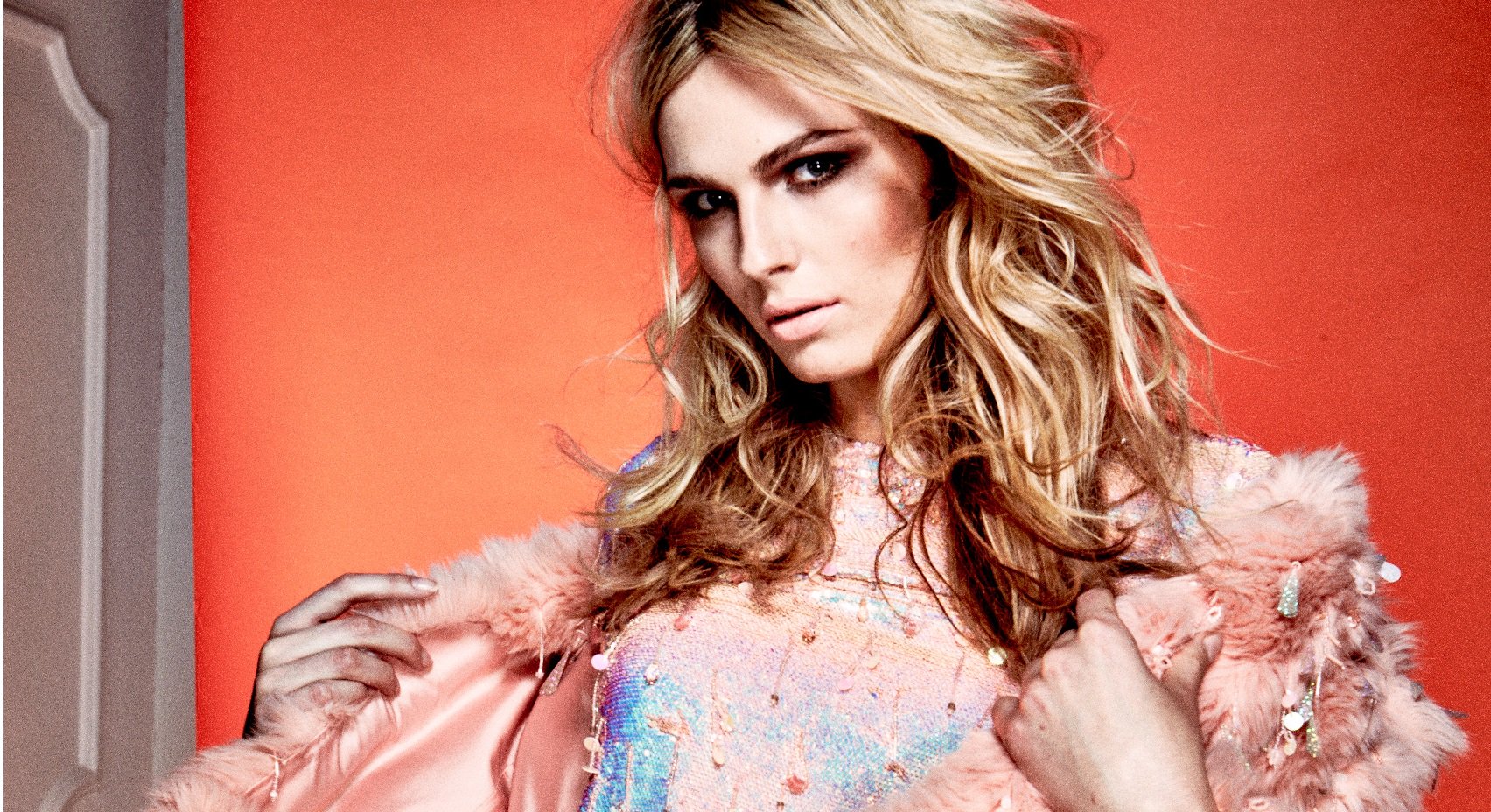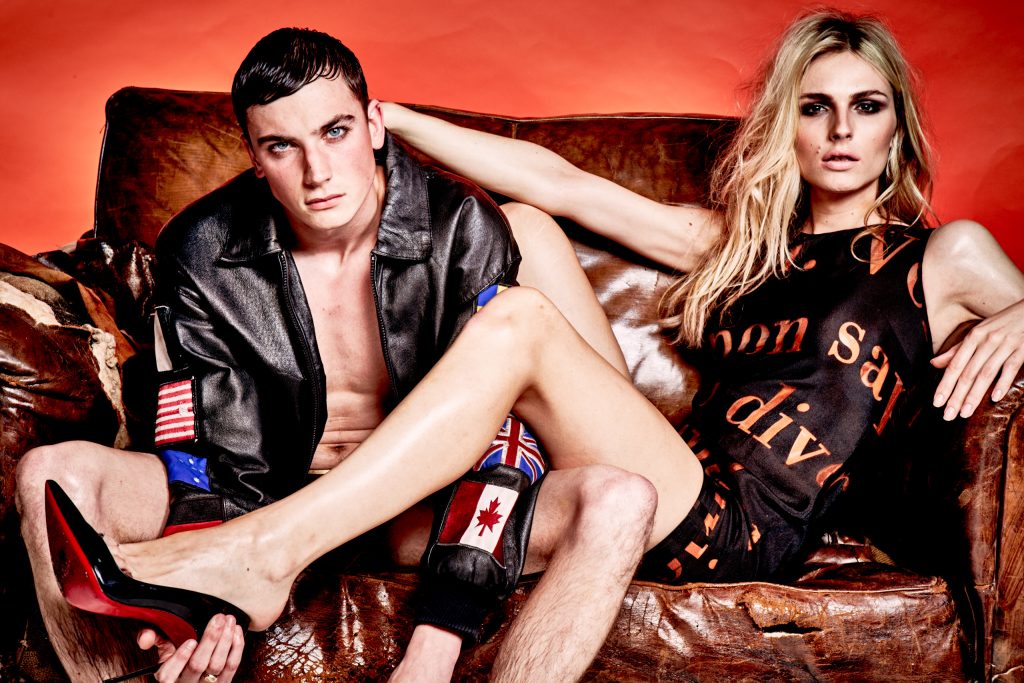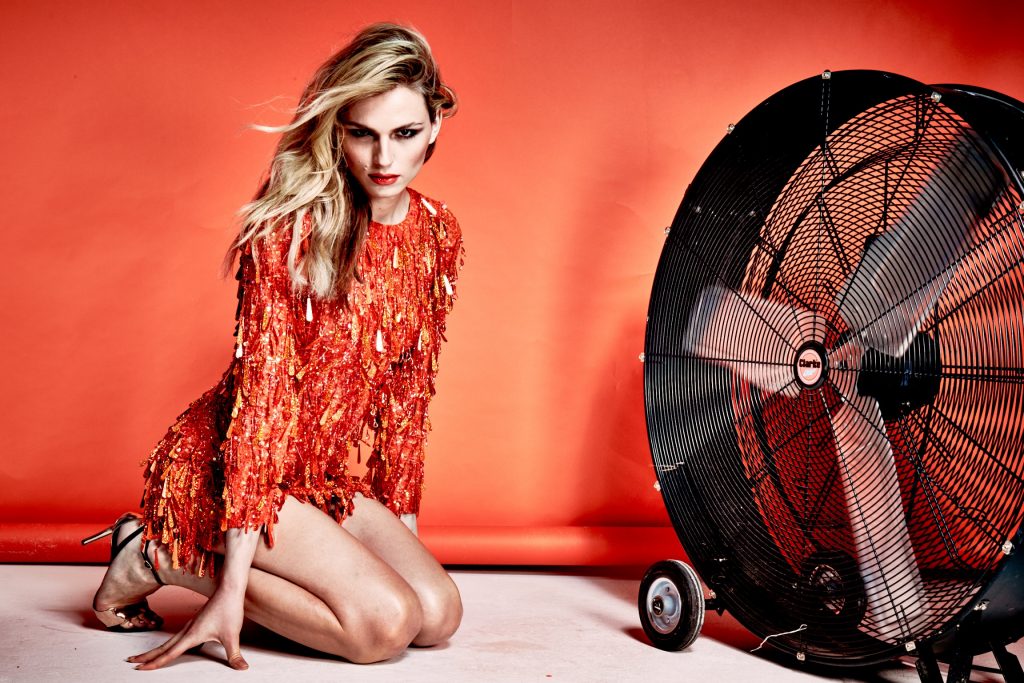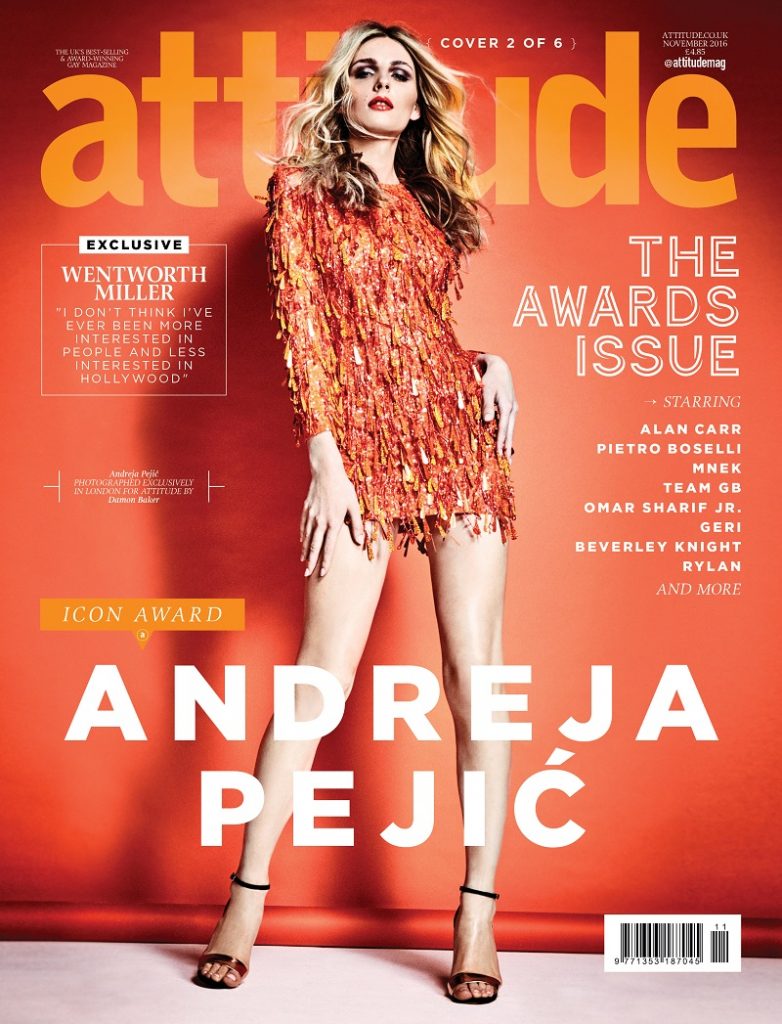Interview | Supermodel Andreja Pejić talks trans youth, Bowie, and the ‘gender tipping point’
By Will Stroude

This interview was first published in Attitude issue 276, November 2016.
After being scouted at the age of 17, it took Andreja Pejić just two years to transform herself into the face of androgynous modelling. At 19 she became the breakout star of the industry, making a name for herself modeling both masculine and feminine clothing for the likes of Jean Paul Gaultier, Vivienne Westwood, and the non-binary face of the advertising campaign for Marc by Marc Jacobs. At 23, Andreja became the first transgender model to be profiled by Vogue.
Andreja Pejić is ancient. “Honestly, 25 in this industry is so old,” she tells me, with a cheeky laugh. I sympathise. Who knew humans could even live that long? “But you know, when I think about it, in the last five years I’ve made quite a few changes in my life in a short period of time. It’s been pretty hectic!”
Well, there’s an understatement. In the past five years Pejić has come out publicly as transgender, fronted an ad campaign for major cosmetic brand Make Up Forever, and appeared in a music video with Tilda Swinton for none other than the late David Bowie. Her rise as a model who could carry-off both men and women’s wear made her an icon of androgyny in the gender-conforming noughties, but since her public transition to female two years ago, she has been finding out just how trans-friendly the fashion world is.
“There’s extra baggage that you have to deal with, and the road definitely has a lot more turns. It can be a beautiful and very freeing experience but at the same time it’s definitely God damn difficult,” she tells me as we chat via Skype.
“What I always say is that we’re living in the best time possible and I can’t really complain, I have a good life now. And that probably wouldn’t have been possible five years ago.”
All this personal and professional change has taken place, of course, against the backdrop of unprecedented change for trans people. Trans has proven to be more than just a trend, it is one of the defining social justice movements of the modern era.
“When I was working in androgyny everyone was saying, ‘Oh this is very unique, it’s very fifteen minutes, it’s not like this can become a trend, it’s so specific’,” she says.
“Now you have a whole generation of kids who are exploring sexuality and gender and not defining themselves as exclusively male or female, mixing and matching masculine and feminine styles. It’s nice to have contributed to this change, at least stylistically if nothing else. It’s definitely a period that I am proud of.”
While Pejić has become an icon to a generation of kids who are questioning their gender and sexuality, she is mindful that she stands on the shoulders of giants. She looks up to Tracy Africa, the former Clairol model whose career ended when rumours about her trans status emerged in the 1980s. Africa, a trans woman of colour, has since re-entered the public spotlight, and modeling, but her story highlights just how bad things were for trans people not so long ago. “Back then if someone outed them, everything would end,” says Pejić, who also lists British trans pioneers Caroline Cossey and April Ashley as inspirations.
Even before she went through a very public transition, Andreja faced other challenges to her identity. Born in Bosnia Herzegovina to a Bosnian Serb mother and a Bosnian Croat father, who were divorced soon after she was born, Andreja was forced to live in a Belgrade refugee camp, with her mother, grandmother and brother Igor during the Bosnian War.
Following the bombing of Yugoslavia by Nato forces, the family decided to leave Europe, finally settling in Melbourne, Australia, as political refugees in 2000. Andreja was just eight years old.
Here she tells Attitude her thoughts on the fashion industry, hormone blockers for trans kids, and why being a child refugee has had as much of an impact on her life as being trans has…

Andreja on…
Transitioning during her modelling career:
My plan was to transition and just go to university. I didn’t plan on modelling. I was discovered working at McDonald’s and at the time I was living a pretty gender fluid life and my agents found it interesting that “boy” could be so pretty, so I went with it and put my uni and completing transition off. Some things could have been easier, commercial success and money would have been a lot easier than it was [had I transitioned] but at the same time I don’t think I would have had the same impact. It’s part of my history and it’s part of who I am. And I have all these beautiful pictures and I look at them and I think they’re great.
Defining her own style:
I wanted a gender fluid style to match my persona and I would look at the 80s a lot, and the 70s. There was no gender fluidity in the 2000s, so I think that when I came out it was something new for that time. I had a lot of fun.
Identity:
Obviously, I was the same person then as I am now. Interviewers would ask, ‘Well are you a man or a woman?’ and I would say ‘Why does it matter? Pass’. Why is gender that important? I don’t go around my house thinking every thought as a woman. Ideas don’t have a gender.
Working with David Bowie:
It was one of the most amazing things I’ve ever done in my career. I was 21 at the time and my agent just said ‘Oh you’re an option for this top secret thing, I can’t tell you what it is until you’re approved’, and I was like, what the hell could it be? And then they were like, they want you to be in David Bowie’s first music video in ten years. What could be cooler than that? He was lovely. His ideas were amazing and he asked all sorts of questions and was very in tune with pop culture and just cool, very chilled and down to earth. He made me feel very comfortable.
Would a cis-gender male celebrity date a trans person?
I think today most male celebrities would be scared of dating a trans woman publicly because I don’t know, they need to be the beacons of masculinity or whatever. In the next few years I’m sure you will see an A-list couple where one is a trans woman, or even a trans man. And hell, yes there are celebrities who are down for trans women, it’s been happening but on the DL.
Her own A-List celebrity kiss and tells:
Well, a girl never kisses and tells!
Her career plans:
I want to have the kind of career I could have had if I just did it as a girl. Fashion is slowly getting used to the idea of trans models, but it could go faster. I think a lot of fashion houses are thinking about what this could add to their brands or their creativity. In the press you’ll hear that trans models are really having a moment, and you go, well there are two models doing well – we still have a lot of road blocks in front of us. I actually see a bigger change in TV, that’s accelerating quite quickly, so I’m sure that fashion will move along as well.
Her experience as a refugee:
My experience of being a refugee has shaped my life just as much as being trans. It decided where I live, it decided what school I go to, everything. We’re creating millions and millions of refugees. It’s not something that’s declining, it’s increasing – and then all of those human rights treaties that were supposed to protect refugees or asylum seekers are breaking down or are being completely ignored while countries are becoming more nationalist and not letting people in, and it’s horrific.

Being emotionally strong:
I’ve always been pretty strong emotionally. I kind of feel like my imagination saved my life. I had a very loving mother and we struggled along. We were very poor, we lived in a refugee camp and it wasn’t easy for her. She’s one of the biggest inspirations in my life. But she was so loving. She bathed us with so much love and affection. When I told her about being trans she didn’t know anything about it or what it meant, but she was closed off to the idea at the time, but she loved us both so much that nothing – nothing – could take away from that. It was just something we had to get through and find a solution that worked for me, so I had support and that helped.
Knowing she wanted to transition at an early age:
I also think that discovering things early on and starting puberty blockers early honestly went a long way in making me feel comfortable in my own skin, because puberty was something that I was shit scared of. I would look at my father and my brother and they would be giant, butch men and I thought, this is what is gonna happen to me and things are going to change irreversibly. So starting that I think helped.
Respecting trans children:
I can sympathise with parents who are fearful to treat a child so young, but if you look at the medical community in terms of helping us out, if you look at the data, if you look at the facts and the experiences, for example, of trans kids in the Netherlands, where they’ve been helped quite young for longer than other places in the world, actually people who start younger do feel on average more adjusted and happier with their transition. And, from purely personal experience, you know when you’re a child. You just know.
They analyse those kids – they put them through rigorous psychological testing, and obtain medication that is reversible. Usually at 12 they give puberty blockers and that can be reversed, and then by usually around 15 or 16 they definitely know. I definitely do not agree with what is a pretty right wing campaign against the treatment of children and trans people in general.
The bathroom debate:
Anyone should be able to use any bathroom they want. We live in a civilised society. Most human beings are capable of going to a toilet and doing what they need to do and then leaving. It’s just an attack on democratic rights at the end of the day, on the LGBT population and the population as a whole. It’s wrong and it has to be opposed.
Trans rights are human rights:
The world is in a scary place. You have fascist right wing forces coming back again to the spotlight and you know those camps are opposed to democracy and I think what the trans community has been fighting for are basic human rights. We may be more visible, we may be more in the spotlight, but overall I think that democracy is going downhill in most Western countries. And that’s scary for trans people and the rest of the LGBT community, it’s scary for other minorities and it’s scary for poor people, too. The only positive thought is that a lot of young people are waking up and getting more involved politically.
What cis-gender people could learn from the trans community:
Stop being so straight and so boring.
Her message to young trans people:
Go out there and slay!
Attitude’s Awards issue is still available to download here. Meanwhile, our January issue is available to download and in shops now. Available internationally from newsstand.co.uk/attitude.

More stories:
Hunky boyfriends become husbands-to-be after adorable flash mob proposal
Hot Peruvian chef Franco Noriega shares eye-popping Instagram story (NSFW)
